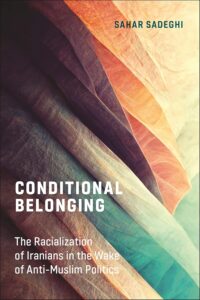 Conditional Belonging: The Racialization of Iranians in the Wake of Anti-Muslim Politics in Europe
Conditional Belonging: The Racialization of Iranians in the Wake of Anti-Muslim Politics in Europe
Sahar Sadeghi
NYU Press, 2023
Iranians have a complex and contradictory relationship with race. Though categorized as “white” by the US census, many Iranian Americans remain marginalized, and experience racial and political stigma daily. On the other hand, Iranian Germans who have been in Germany for decades, and are typically regarded as ‘good foreigners,’ continue to experience marginality and discrimination illustrating the limitations of integration and citizenship. Conditional Belonging explores these apparent contradictions through a comparative analysis of the Iranian diasporic experience in the United States and Germany, focusing particularly on the different processes of racialization of the immigrants.
Drawing from eighty-eight interviews with first- and second-generation Iranians living in California and Hamburg, Sahar Sadeghi illuminates how international events, global political policy, and national social climates influence the extent to which Iranians define themselves as members of their adopted nations. All these factors lead to radically different experiences of belonging, or more specifically “conditional belonging,” for Iranians living in Western nations—while those in America might have situational access to whiteness, this is not always available to Iranians in Germany. The combination of these experiences results in perceptions, narrations, and experiences of what the author calls “being but not belonging.” Conditional Belonging is an important and timely book that broadens our understanding of how unpredictable and fluid a sense of belonging to a country can be.

The internet and formations of Iranian American-ness: Next generation diaspora
Donya Alinejad
Springer, 2017
This book explores how the children of Iranian immigrants in the US utilize the internet and develop digital identities. Taking Los Angeles—the long-time media and cultural center of Iranian diaspora—as its ethnographic field site, it investigates how various web platforms are embedded within the everyday social, cultural, and political lives of second generation Iranian Americans. Donya Alinejad unpacks contemporary diasporic belonging through her discussion of the digital mediation of race, memory, and long-distance engagement in the historic Iranian Green Movement. This book argues that web media practices have become integral to Iranian American identity formation for this generation, and introduces the notion of second-generation “digital styles” to explain how specific web applications afford new stylings of diaspora culture.
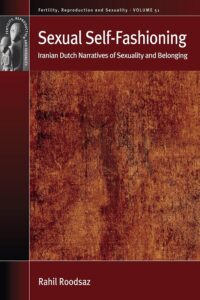 Sexual Self-Fashioning: Iranian Dutch Narratives of Sexuality and Belonging
Sexual Self-Fashioning: Iranian Dutch Narratives of Sexuality and Belonging
Rahil Roodsaz
Berghahn Books, 2021
Anthropologist Rahil Roodsaz investigates Iranian Dutch narratives of sexuality and belonging in her book Sexual Self-Fashioning: Iranian Dutch Narratives of Sexuality and Belonging, addressing the ways in which sexuality and gender have come to serve as measures for cultural belonging in discussions of the position of Muslim immigrants in multicultural Western societies.
While the acceptance of assumed local norms such as sexual liberty and gender equality are seen as successful integration, rejecting them is regarded as a sign of failed citizenship. Focusing on premarital sex, homosexuality, and cohabitation outside marriage, Sexual Self-Fashioning: Iranian Dutch Narratives of Sexuality and Belonging provides an ethnographic account of sexuality among the Iranian Dutch. It argues that by embracing, rejecting, and questioning modernity in stories about sexuality, the Iranian Dutch actively engage in processes of self-fashioning.
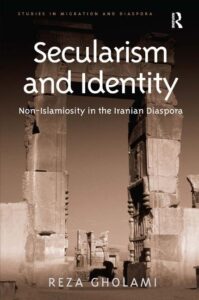
Secularism and Identity: Non-Islamiosity in the Iranian Diaspora
Reza Gholami
Routledge, 2015
Within western political, media and academic discourses, Muslim communities are predominantly seen through the prism of their Islamic religiosities, yet there exist within diasporic communities unique and complex secularisms. Drawing on detailed interview and ethnographic material gathered in the UK, this book examines the ways in which a form of secularism – ’non-Islamiosity’ – amongst members of the Iranian diaspora shapes ideas and practices of diasporic community and identity, as well as wider social relations. In addition to developing a novel theoretical paradigm to make sense of the manner in which diasporic communities construct and live diasporic identity and consciousness in a way that marginalises, stigmatises or eradicates only ’Islam’, Secularism and Identity shows how this approach is used to overcome religiously inculcated ideas and fashion a desirable self, thus creating a new space in which to live and thereby attaining ’freedom’. Calling into question notions of anti-Islamism and Islamophobia, whilst examining secularism as a means or mechanism rather than an end, this volume offers a new understanding of religion as a marker of migrant identity. As such it will appeal to scholars of sociology, anthropology and political science with interests in migration and ethnicity, diasporic communities, the sociology of religion and emerging forms of secularism.
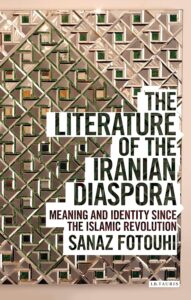 The literature of the Iranian diaspora: Meaning and identity since the Islamic revolution
The literature of the Iranian diaspora: Meaning and identity since the Islamic revolution
Sanaz Fotouhi
Bloomsbury Publishing, 2015
The 1979 Revolution in Iran caused the migration of millions of Iranians, many of whom wrote, and are still writing, of their experiences. Formed at the junctions of Iranian culture, English language and Western cultures, this body of work has not only formed a unique literary space, offering an insightful reflection of Iranian diasporic experiences and its shifting nature, but it has also been making a unique and understudied contribution to World Literatures in English as significant as Indian, African and Asian writing in English. Sanaz Fotouhi here traces the origins of the emerging body of diasporic Iranian literature in English, and uses these origins to examine the socio-political position and historical context from which they have emerged.
Fotouhi brings together, introduces and analyses, for the first time, a significant range of diasporic Iranian writers alongside each other and alongside other diasporic literatures in English. While situating this body of work through existing theories such as postcolonialism, Fotouhi sheds new light on the role of Iranian literature and culture in Western literature by showing that these writings distinctively reflect experiences unique to the Iranian diaspora. Analysing the relationship between Iranians and their new surroundings, by drawing on theories of migration, narration and identity, Fotouhi examines how the literature borne out of the Iranian diaspora reconstructs, maintains and negotiates their Individual and communal identities and reflects today’s socio-political realities. This book will be vital for researchers of Middle Eastern literature and its relationship with writings from the West, as well as those interested in the cultural history of the Middle East.
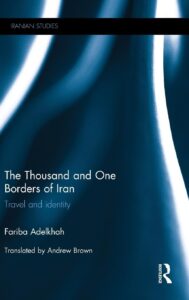
The Thousand and One Borders of Iran: Travel and Identity
Fariba Adelkhah
Routledge, 2016
Kate Millett was already an icon of American feminism when she went to Iran in 1979. She arrived just weeks after the Iranian Revolution, to join Iranian women to celebrate International Women’s Day. Millett, armed with film equipment and a cassette deck to record everything around her, found herself in the middle of demonstrations for women’s rights and against the mandatory veil. Millett documented her experience, later publishing Going to Iran in 1982. Various researchers have inspired by recorded documents, but this time, Negar Mottahedeh offers a new interpretation of women’s, and revolutionary men opposing them, by studying the audio tapes Millett recorded. Inspired by Foucauldian view the author argues that Millett failed to grasp the second, contextualized narrative, captured in the shouts and quiet conversations in Persian, which does not align with Millett’s narrative of the protests. However, Mottahedeh does not go further into analyzing Millett’s book.
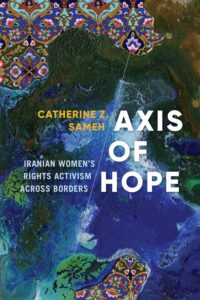 Axis of Hope: Iranian Women’s Rights Activism across Borders
Axis of Hope: Iranian Women’s Rights Activism across Borders
Catherine Zameh
Stanford University Press, 2019
Political tensions between Iran and the United States in the post-9/11 period and the Global War on Terror have set the stage for Iranian women’s rights activists inside and outside Iran as they seek full legal equality under the Islamic Republic. Axis of Hope recounts activists’ struggles through critical analysis of their narratives, including the One Million Signatures Campaign to End Discriminatory Law, the memoirs of human rights lawyer and Nobel Prize–winner Shirin Ebadi, and the life story of feminist Mahboubeh Abbasgholizadeh and her activist project ZananTV. Catherine Sameh examines how Iranian women’s rights activists have cultivated ways of thinking of and being with each other that rupture the relentless difference-making and violence of coloniality through local and transnational networks along axes of feminist solidarity, friendship, and love.
Crucial to countering despair and cynicism about Iran as well as the dangerous interventions by Western powers “on behalf of” Iranians, activists’ experiences speak to the possibilities and challenges of transnational alliances in confronting oppressive regimes. These stories are particularly germane in such precarious times, marked by war, isolation, sanctions, and the intense demonization of Iranians and Muslims, as well as authoritarianism, militarism, and patriarchal nationalisms around the world. Situating postreform women’s rights activism within the unfolding, decades-long project to democratize Iran from within, Axis of Hope makes a timely contribution to studies of feminist movements, women’s human rights in Muslim contexts, activism and new media, and the relationship between activism, civil society, and the state.
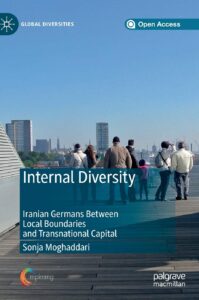
Internal Diversity: Iranian Germans Between Local Boundaries and Transnational Capital
Sonja Moghaddari
Berghahn Books, 2020
This book explores the interrelation between diversity in migrants’ internal relations and their experience of inequality in local and global contexts. Taking the case of Hamburg-based Iranians, it traces evaluation processes in ties between professionals – artists and entrepreneurs – since the 1930s, examining migrants’ potential to act upon hierarchical structures. Building on long-term ethnographic fieldwork and archival work, the book centers on differentiation, combining a diversity study with a focus on locality, with a transnational migration study, analysing strategies of capital creation and anthropological value theory. The analysis of migrants’ agency tackles questions of independence and cooperation in kinship, associations, transnational entrepreneurship and cultural events within the context of the position of Germany and Iran in the global politico-economic landscape. This material will be of interest to scholars and students of anthropology, sociology, migration, urbanism and Iranian studies, as well as Iranian-Germans and those interested in the entanglement of global and local power relations.
* Summaries are adapted from publishers’ websites with minor edits.
ISSN 2818-9434



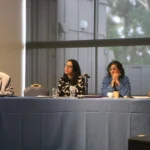




Comments are closed.